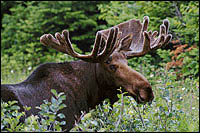 WHY
DO MOOSE CROSS THE ROAD?
WHY
DO MOOSE CROSS THE ROAD?  WHY
DO MOOSE CROSS THE ROAD?
WHY
DO MOOSE CROSS THE ROAD?
Because they're too big to try bungee jumping
From Newsweek, October 21, 1991 • A Jason-K Exclusive!
Section: ENVIRONMENT
Dateline: Moose country
 |
Do you chuckle at the preposterous sight of a moose ambling into town on "Northern Exposure." No one's laughing in New England where moose and man are meeting with dire consequences. Earlier this year in Manchester, N.H., one of the gangly creatures not only came into town but climbed onto a factory roof. As humans rushed to its rescue, it fell off the building and died. In the Boston suburb of Natick, Mass., a startled family recently discovered a moose nibbling on the lawn. State animal wardens were called; while families watched, the officers pulled out their shotguns and blasted the animal. One dark night last month outside Burlington, Vt., David Kemp's Jeep Cherokee smashed into a 1,100-pound bull moose standing in the middle of the road. "There was no chance," Kemp said later. He was unharmed but the moose and the car were a mess. |
Why do the moose keep crossing the road? "This time of year they keep wandering, trying to find a mate," says Howard Nowell of New Hampshire's Fish and Game Department. "Too often they wind up finding a car." On the highways of northern New England, the fall foliage season has turned into a time of moose carnage. In their natural habitat, the moose population has been actually booming, up from near extinction a century ago to a herd of 21,000 in Maine alone. "They're probably more abundant today than they've ever been," says Fred Hurley of Maine's Resource Management Bureau. As the herds increased, so did the number of moose-car collisions. In Maine, more than 300 moose were hit in 1989, twice the total of the decade before, In New Hampshire, which has a herd of 4,000, there have been 163 moose wrecks so far this year, including four that caused human fatalities.
When a car hits a moose, both sides lose. An adult bull weighs in excess of 1,000 pounds. And it stands about six feet high, so its eyes are not as likely to reflect headlights as a deer's. Color is also a drawback: a moose's legs are dusky gray so drivers often don't detect them until the last millisecond. Most smaller animals get hit by the grille; the damage is confined to the car's front end. But a typical collision with a lanky moose sweeps the animal over the hood. "What you get is that massive center of gravity coming through the windshield and over the roof," says Vermont state biologist Cedric Alexander.
One solution is good news for taxidermists but bad news for environmentalists. Maine eliminated moose hunting in 1935 but reinstated it on a regular basis in 1982; this year there were 82,000 applicants for the state's 1,000 six-day permits. New Hampshire has just bumped up the number of permits from 75 to 100 and increased the hunting season from three to 10 days. Another approach is to educate drivers to slow down. It's especially critical that motorists drive defensively over the next few weeks: the fall is moose-rutting season.
Inset Article
ON THE LOOSE
• They are the animals of the moment. Bullwinkle is making a comeback on video. "Northern Exposure" is red hot. Even Canada's Moosehead beer is exporting more than 5 million cases this year.
• Roughly 30,000 moose live in New England. More roam through northern forests from Siberia and Scandinavia to Alaska, Canada and the Rockies.
• The largest weigh 1,800 pounds and stand more than seven feet tall.
Created
2/12/02
Back to Articles Main • Moosechick
Notes Main Page
Northern Exposure is Copyright © Universal City Studios. All Rights Reserved.